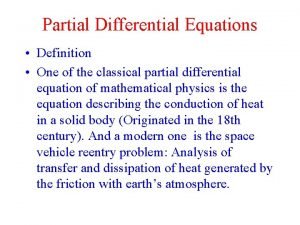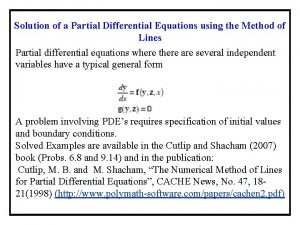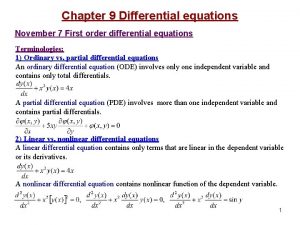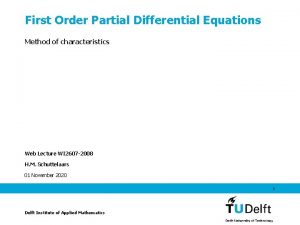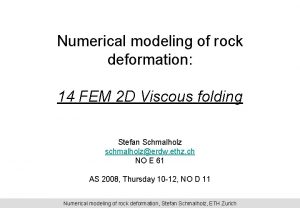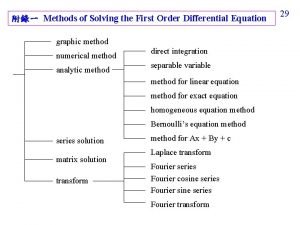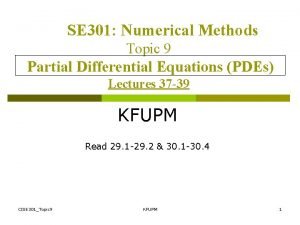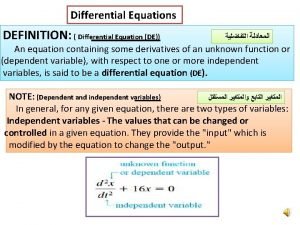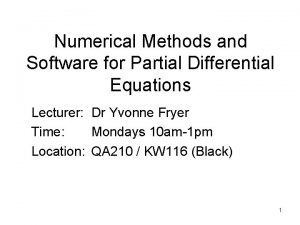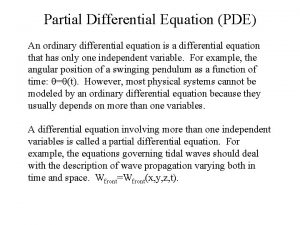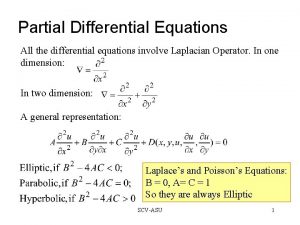Chapter 4 Partial Differential Equation PDE 1 Partial























- Slides: 23

Chapter 4 Partial Differential Equation (PDE) 1

Partial Differential Equation, Or PDE For example 2

3

Temperature distribution on a heated plate Laplace equation 4

Two-Dimensional Steady state Conduction 5

Numerical Analysis (Finite Difference Solutions) 6

7

Example 2 Liebmann’s Iteration method (Gauss-Seidel) 8

The ninth iteration gives the result where the maximum error is 0. 71%. 9

The rate of heat flux across the plate 10

Example 3 Employ the results of Example 2 to determine the distribution of heat flux for the heated plate. Assume that the plate is 40 x 40 cm and is made out of aluminum [k = 0. 49 cal/(s , cm. C)]. For i = j =1 11

12

Numerical Analysis with convective boundary condition 13

Numerical Analysis with Convection at an exterior corner 14

- Cramer’s Rule - GAUSS ELIMINATION - Gauss Seidel Iteration Method 15

Example 2 A large industrial furnace is supported on a long column of fire clay brick, which is 1 m by 1 m on a side. During steady state operation, installation is such that three surfaces of the column are maintained at 500 K while the remaining surface is exposed to an air stream for which T∞ =300 K and h=10 W/m 2 K. Using a grid of Dx = Dy =0. 25 m, determine the two-dimensional temperature distribution in the column. 16

17

18

Example 3 Consider the square in Figure. The left face is maintained at 100 ◦C and the top face at 500 ◦C, while the other two faces are exposed to an environment at 100 ◦C: h=10 W/m 2 ・ ◦C and k =10 W/m・ ◦C The block is 1 m square. Compute the temperature of the various nodes as indicated in of Figure and the heat flows at the boundaries. The nodal equation for nodes 1, 2, 4, and 5 is 19

The equation for nodes 3, 6, 7, and 8 is given by 20

the equation for 9 is given by Equation 21

Exercise : 1 - Calculate the steady-state temperatures for nodes 1 to 6 in Figure 22

2 - The fin shown in Figure has a base maintained at 300 ◦C and is exposed to the convection environment indicated. Calculate the steady-state temperatures of the nodes shown and if k =1. 0 W/m· ◦C. 23
 Pde differential equation
Pde differential equation General solution of partial differential equation
General solution of partial differential equation What is linear differential equation
What is linear differential equation Integrating partial differential equations
Integrating partial differential equations Order of partial differential equation
Order of partial differential equation Explicit method
Explicit method Classification of pde
Classification of pde Define differential equation
Define differential equation The solution of partial differential equation
The solution of partial differential equation Lieberman
Lieberman What is euler‟s equation
What is euler‟s equation First order differential equation chapter 9
First order differential equation chapter 9 Partial differential protection
Partial differential protection Order and degree of differential equation ppt
Order and degree of differential equation ppt Method of characteristics
Method of characteristics Numerical methods for partial differential equations eth
Numerical methods for partial differential equations eth First-order linear equations
First-order linear equations Crank nicolson method
Crank nicolson method Standards aligned system
Standards aligned system Paul heckbert
Paul heckbert Mais educação
Mais educação Definition of differential equation
Definition of differential equation Pims pde
Pims pde Classification of pde
Classification of pde
